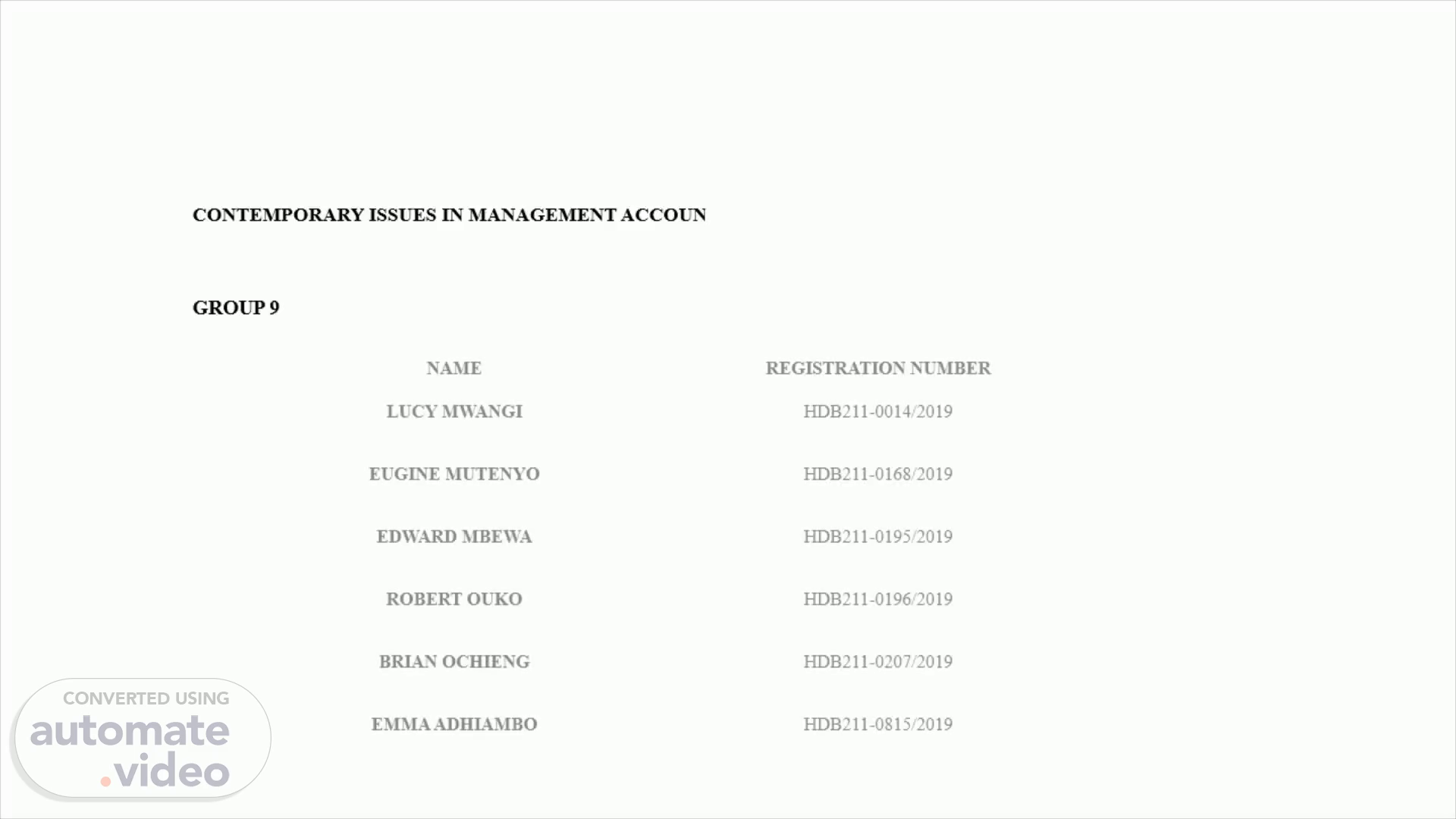
CONTEMPORARY ISSUES IN MANAGEMENT ACCOUNTING GROUP 9
Scene 1 (0s)
CONTEMPORARY ISSUES IN MANAGEMENT ACCOUNTING GROUP 9.
Scene 2 (14s)
Business Process Reengineering (BPR). Business Process Reengineering (BPR) is a management practice in which the related tasks required to obtain a specific business outcome are radically redesigned. A major aim of BPR is to analyze workflows within and between business functions to optimize the end-to-end business process and eliminate tasks that do not improve performance or provide the customer with value. It also t he use of IT to automate and integrate steps in the process is central to BPR initiatives..
Scene 3 (36s)
Benefits of business process reengineering. Frequently updating business operations ensures the company stays up-to-date on procedures and technology. Here are some benefits of business process reengineering: Reduced operational costs Enhanced quality of products or services Increased speed of business operations Improved customer service Boosted profits Clarified purpose.
Scene 4 (52s)
Principles of BPR. These principles were laid out by Hammer and organizational theorist James Champy in Reengineering the Corporation A Manifesto for Business Revolution, which became a national bestseller. To achieve significant improvement in quality, time management, speed and profitability, the authors urged businesses to follow seven principles: Organize around outcomes, not tasks. Identify all the processes in an organization and prioritize them in order of redesign urgency. Integrate information processing work into the real work that produces the information. Treat geographically dispersed resources as though they were centralized. Link parallel activities in the workflow instead of just integrating their results. Put the decision point where the work is performed and build control into the process. Capture information once and at the source..
Scene 5 (1m 25s)
Five-Step Approach in Redesigning Business Processes.
Scene 6 (1m 36s)
BPR team member roles. The radical change advocated by BPR required serious commitment from a company's top executives each with their roles Team leader. A senior executive who has envisioned and authorized the overall reengineering effort. The team leader is responsible for appointing the process owner. Process owner. A senior-level manager in charge of a specific business process. The process owner is responsible for assembling a team to reengineer the process they oversee. Reengineering team. A group that is composed of insiders whose work involves the process that is being reengineered and outsiders whose jobs are not affected by changes in process. The reengineering team is responsible for analyzing the existing process and overseeing its redesign. Steering committee. A group of senior managers who have championed the concept of reengineering within the organization and set specific goals for improving performance. The steering committee, which is led by the team leader, is responsible for arbitrating disputes and helping process owners make decisions about competing priorities. Reengineering czar. An individual who is responsible for the day-to-day coordination of all ongoing reengineering activities. The czar's responsibility is to be a facilitator and develop the techniques and tools the organization uses to reengineer workflow..
Scene 7 (2m 24s)
Continuous Improvement. Continuous improvement is a philosophy or process of making small, incremental improvements over time. These improvements can be made in any area, such as business processes, customer service, product quality, efficiency, etc. This philosophy encourages employees to take initiative and make changes that benefit the company and its customers. By incorporating a continuous improvement approach, companies can increase their competitive advantage, reduce costs, and improve customer satisfaction. Benefits Of Continuous Improvement Improved Quality Improved Efficiency Improved Employee Engagement Improved Adaptability.
Scene 8 (2m 49s)
Principles of continuous improvement The following are the principles of continuous improvement;.
Scene 9 (3m 10s)
Conclusion. In conclusion, BPR and continuous improvement can work together to improve organizational performance. BPR can be used to identify and redesign processes that require significant changes, while continuous improvement can be used to refine and fine-tune those processes over time. It is important to note that BPR is a more drastic approach than continuous improvement, and it may not always be necessary or appropriate to undertake such a comprehensive redesign of business processes. In some cases, incremental changes through continuous improvement may be sufficient to achieve the desired improvements in organizational performance..
Scene 10 (3m 35s)
References. Business Process Reengineering: Automation Decision Points in Process Reengineering by Shari Lawrence Pfleeger and Joanne Atlee Continuous Improvement Tools: A Practical Guide to Achieve Quality Results by Jack B. ReVelle and John W. Moran Continuous Improvement, Probability, and Statistics: Using Creative Hands-On Techniques by William Hooper Kaizen: The Key to Japan's Competitive Success by Masaaki Imai.